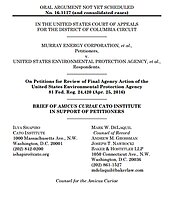Learn more about Cato’s Amicus Briefs Program.
The U.S. Court of Appeals for the D.C. Circuit is considering whether the Environmental Protection Agency acted unreasonably when it issued regulations of hazardous air pollutants from coal and oil power plants under Section 112 of the Clean Air Act, regulations that provide far less than a penny in benefits for each of the nearly $10 billion in costs it imposes on the U.S. economy. If this question sounds familiar, it’s because EPA tried this gambit before—and lost. In Michigan v. EPA (2015)—in which Cato also filed a brief—the Supreme Court rebuffed the agency for its failure to consider the costs of very the same regulations. On remand, EPA doubled down by issuing a supplemental finding that did no more than pay lip service to the Court’s admonition that rules whose benefits are greatly outweighed by their costs are irrational. In light of the agency’s grudging concession that it could quantify only $4 to $6 million in statutorily-defined benefits to “women of child-bearing age in subsistence fishing populations who consume freshwater fish that they or their family caught” in enormous quantities, EPA attempted to justify its $10 billon rule by pointing to other non-statutory benefits, which it euphemistically calls “co-benefits.” As we argue in our new brief, the D.C. Circuit should reject EPA’s end run around the Supreme Court’s decision and statutory limits on its regulatory authority. EPA’s failure to identify anything more than de minimis benefits for an action that will impose billions of dollars of costs is the height of arbitrariness. If EPA cannot justify the regulations forthrightly, it should withdraw them—not re-write the statute to target industries that it disfavors.
